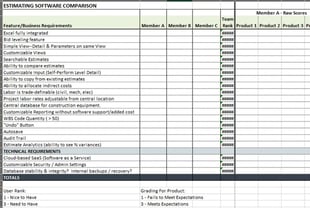Taking the Emotion out of Software Evaluation
Choosing the best estimating software for preconstruction is not only time-consuming, but it can feel like you’re on a roller coaster of disappointments. It could take weeks to schedule a negotiation meeting with your VP only to be told you don’t have the money. Tensions run high when it comes to normal work deadlines, can you imagine the stress of choosing a new estimating platform? This is why you have to set emotions aside and have procedures in place to help you choose what is best for your company.
Can’t Play Favorites
We are all guilty of playing favorites. Whether it be a favorite food or television show, we know what we like and good luck convincing us to change. In the evaluation process, you come across many different vendors. Each with their own way of doing things and their own personality.
It’d be easy to write someone off just because you don’t like their monotone voice, but what if their software meets all your requirements and then some? Chances are you won’t be hearing the monotone voice for long or maybe they’re just having an off day. You might really hit it off with one company that roots for your favorite football team, but do they follow up after a meeting?
This also means your senior estimator can’t cast his vote for software based on what he used for 10 years at a previous company. It doesn’t mean to discount the employee's past experiences but take it with a grain of salt. Yes, he liked that software, but has it been updated in the last decade to fit your team’s needs today?
Decide What’s Important, How Important, and Stick to It
There is a reason you want or need a new construction estimating tool and before you even start evaluating other systems you need to know what that is. Does custom reporting rank at the top of your list or is it team estimating? If you have to still use a separate platform for 2D takeoff, is it worth your team switching? You not only have to decide what is important but how important it is.
Haselden Construction created a Choosing by Advantages matrix where they list each feature and benefit of a potential new estimating system. They use that same matrix for each product evaluation. Matt Hammer, Chief Estimator for Haselden says "you then go through and rank each requirement. A score of one means the feature is nice to have all the way down to three meaning business critical. Once you’ve scored all of these products against your matrix you get a weighted score for each feature. The highest score isn’t necessarily your winner. It could be, but you also have to look at the cost/benefit ratio after you evaluate everything."
Vendor A might show you a nice-to-have functionality for the future but not even have the ability to do team estimating. Don’t get hung up on what looks cool, stick to what your team agreed upon before the evaluation even started.
What is the Timeline?
Timelines are important because you won’t stress yourself out if you logically space out each evaluation deadline. Most companies make it their goal to find new software by end of the quarter or the end of the year. Take that date and work backward. If you have to present your recommendation to leadership, give yourself adequate time to dig deep into the potential software. Scott Warren, VP of Estimating for Ryan Companies, knows the time it takes to evaluating estimating platforms in the right way but also the benefit that comes from spending that time:
“When it came to looking at the estimating platform, we knew we needed to move on from Excel. What would make us better? What would make us more efficient? We evaluated a lot of different platforms. We got in deep with a lot of them. Are we going to be able to break down silos? We have 16 offices throughout the U.S., can we get that consistency across the organization?”
Make sure the timeline is logical for what you want to accomplish. Realistically you can’t evaluate and implement software in a month for a team of 100 estimators. No one should even attempt that…they would lose their mind and probably a good chunk of their estimators if that was a requirement.
When you are considering the evaluation timeline does it include a pilot project or hands-on time with the software? Is the deadline you sent just for choosing the new estimating software or do you want to be implemented by that time? Don’t rely on one person to set this timeline. You have to get feedback from your team but also from each vendor. Be realistic and don’t try to speed up the timeline to just get the project off your plate. You will wind up missing a critical step in the evaluation that your team needs to complete in order to be successful.
Final Thoughts
When your company creates an objective to switch estimating platforms, choose a team to lead this effort. The team needs to not play favorites, decide what’s important, and what the timeline is. The bigger the company, the bigger the evaluation team needs to be. That way you make sure to hear what is necessary for each team member to make the jump and embrace the new estimating platform that is chosen. The change will only happen if everyone is on board with the switch. The desire to change has to come both from top-down and bottom-up to make sure everyone is going after the same end goal.

-1.png?width=112&height=112&name=image%20(4)-1.png)















